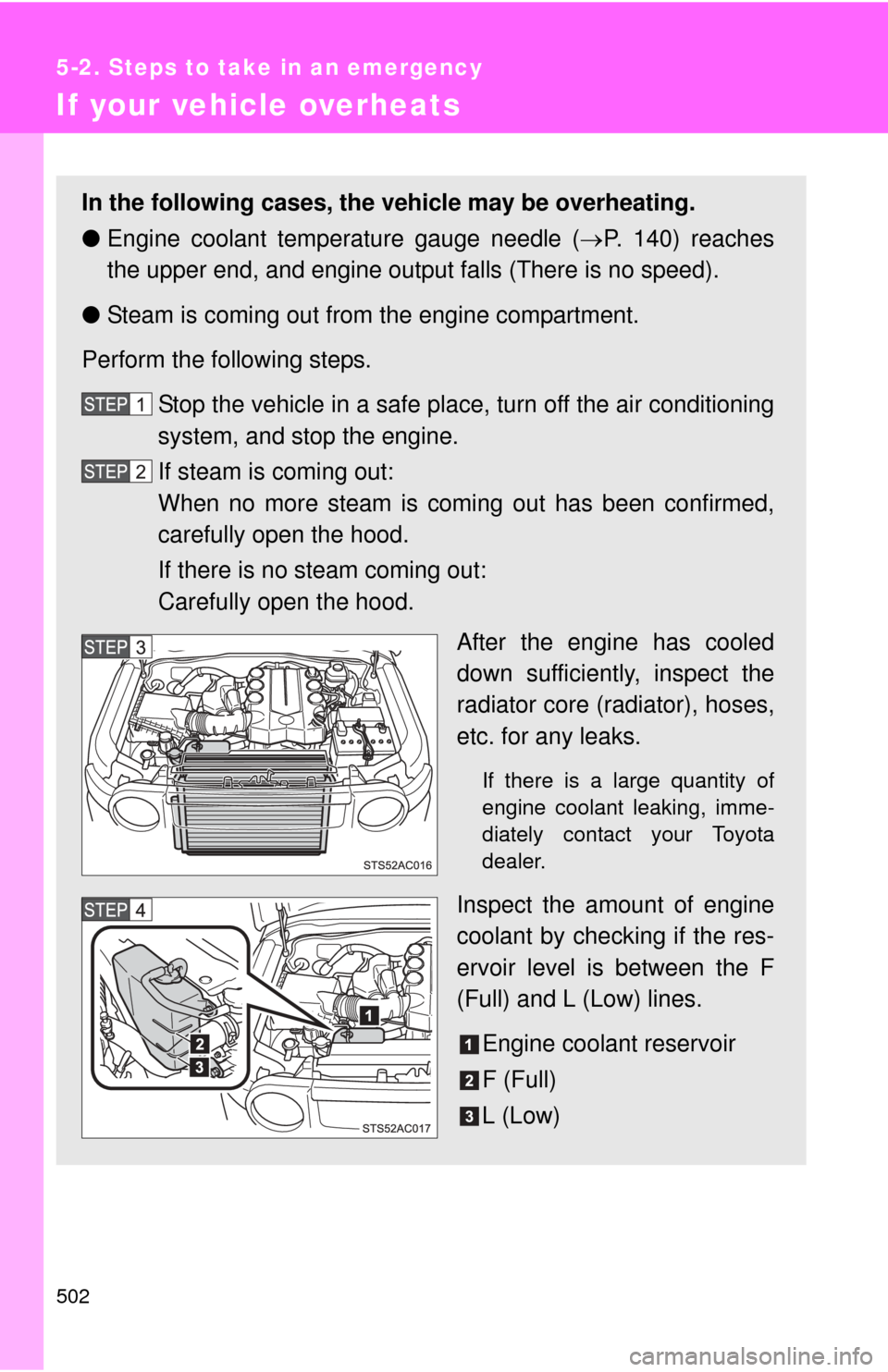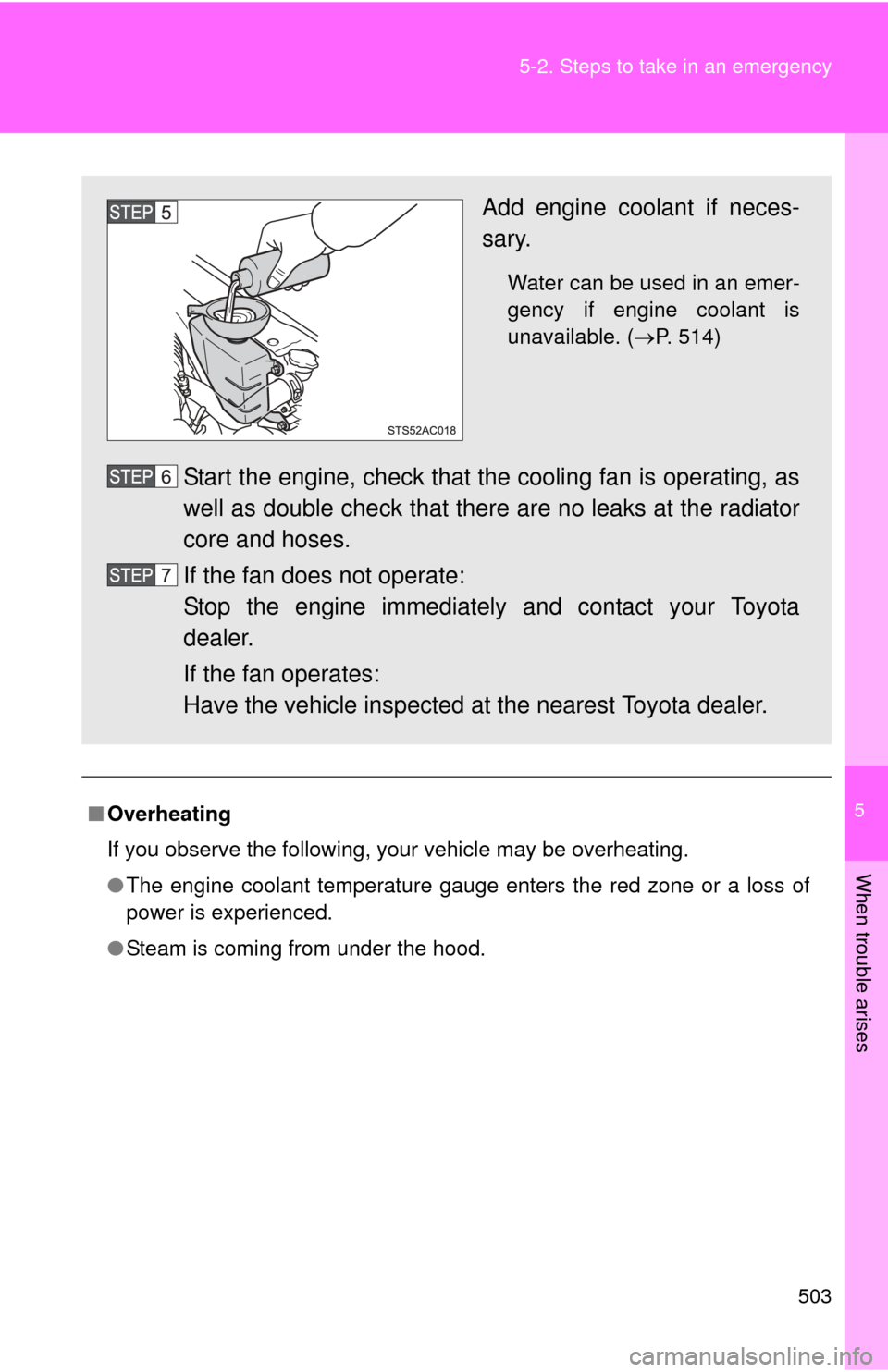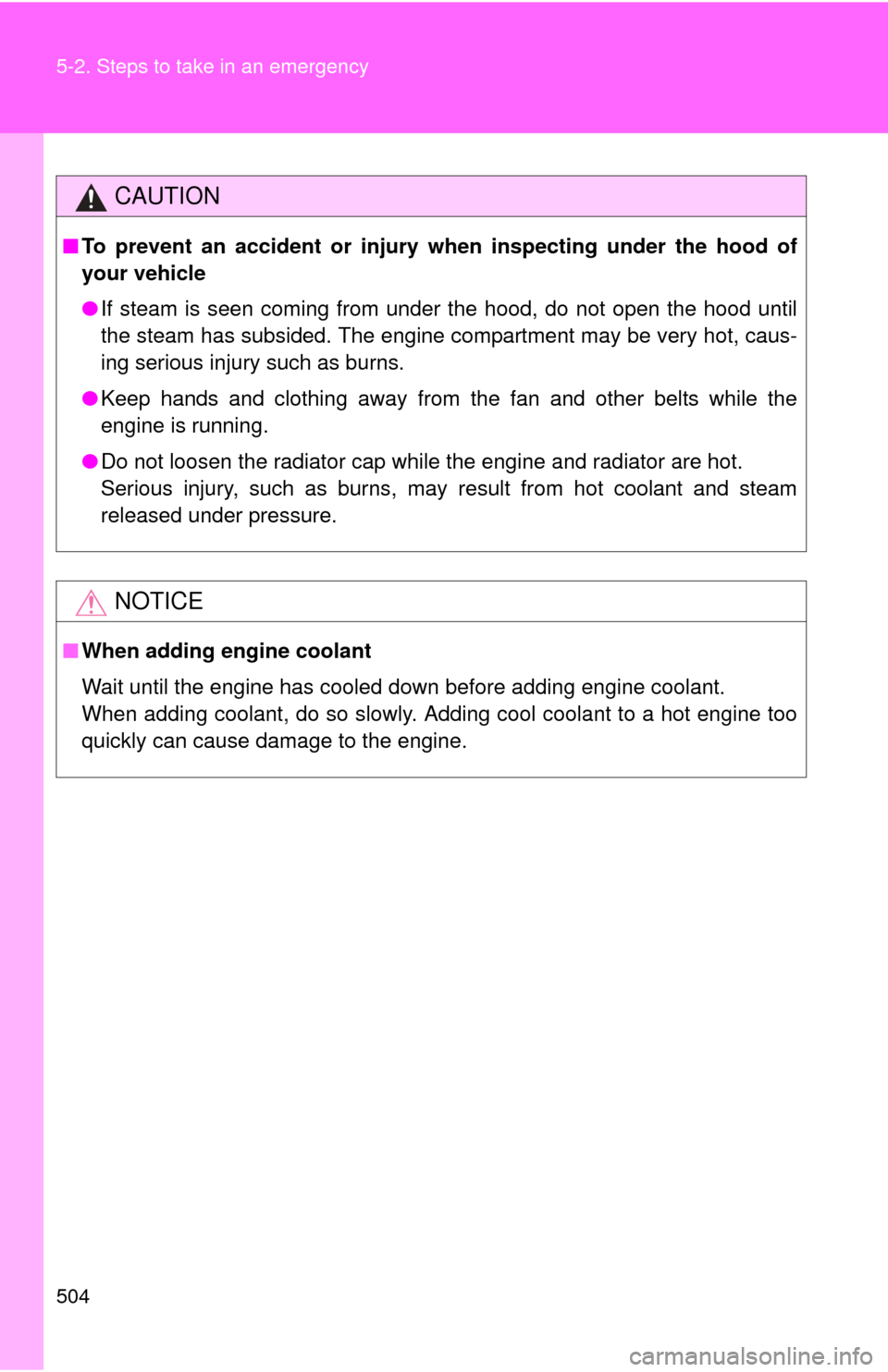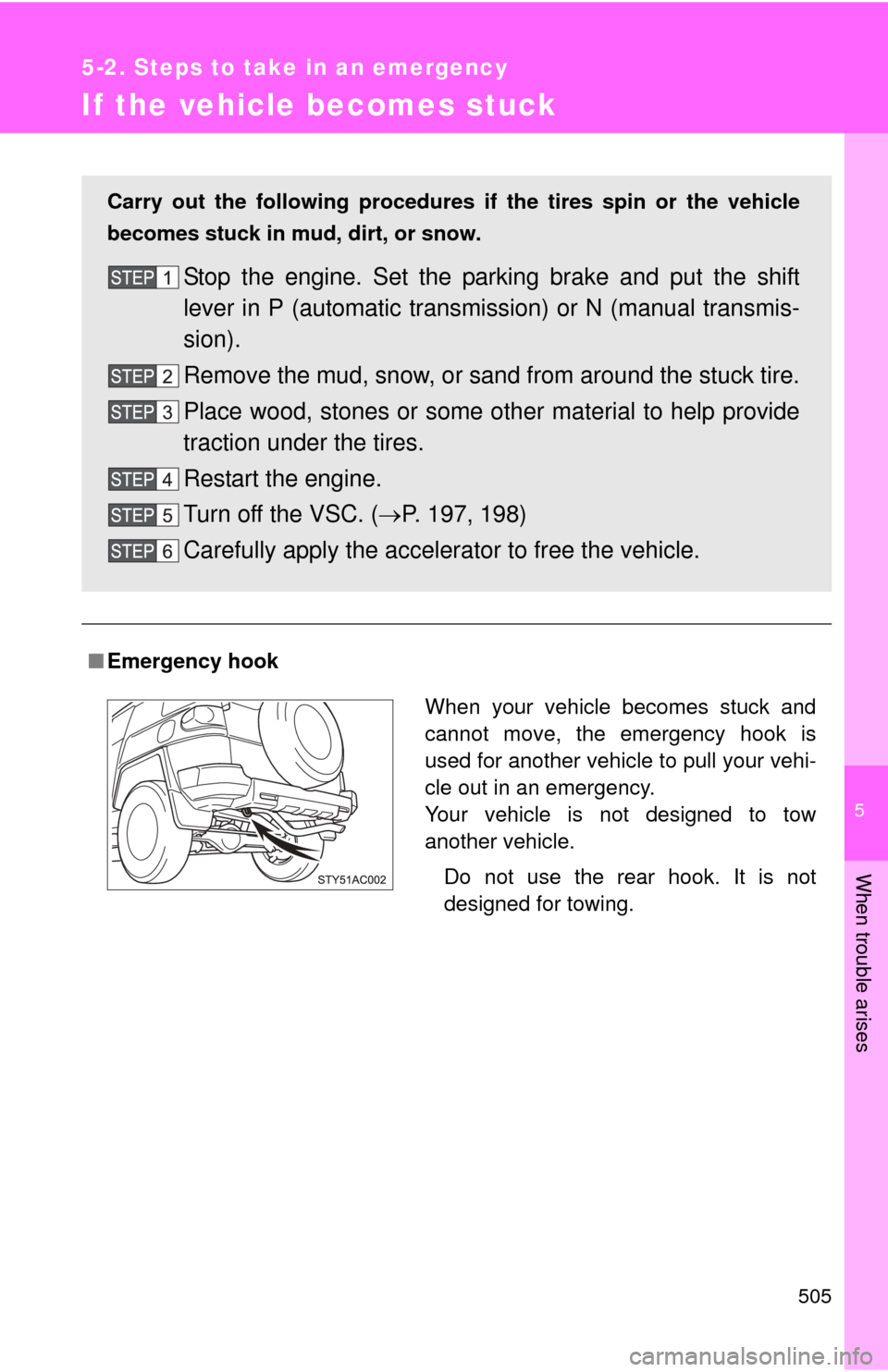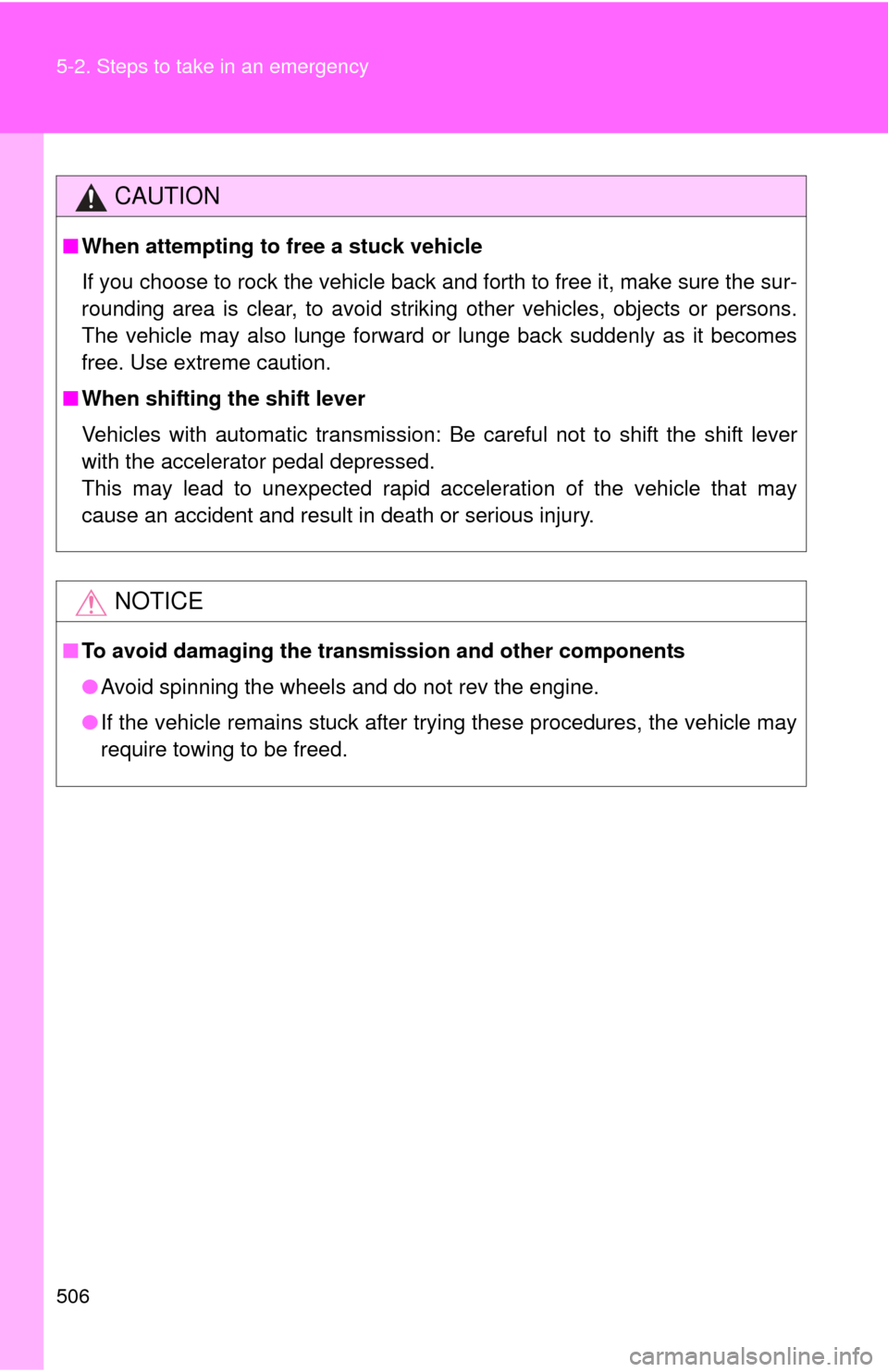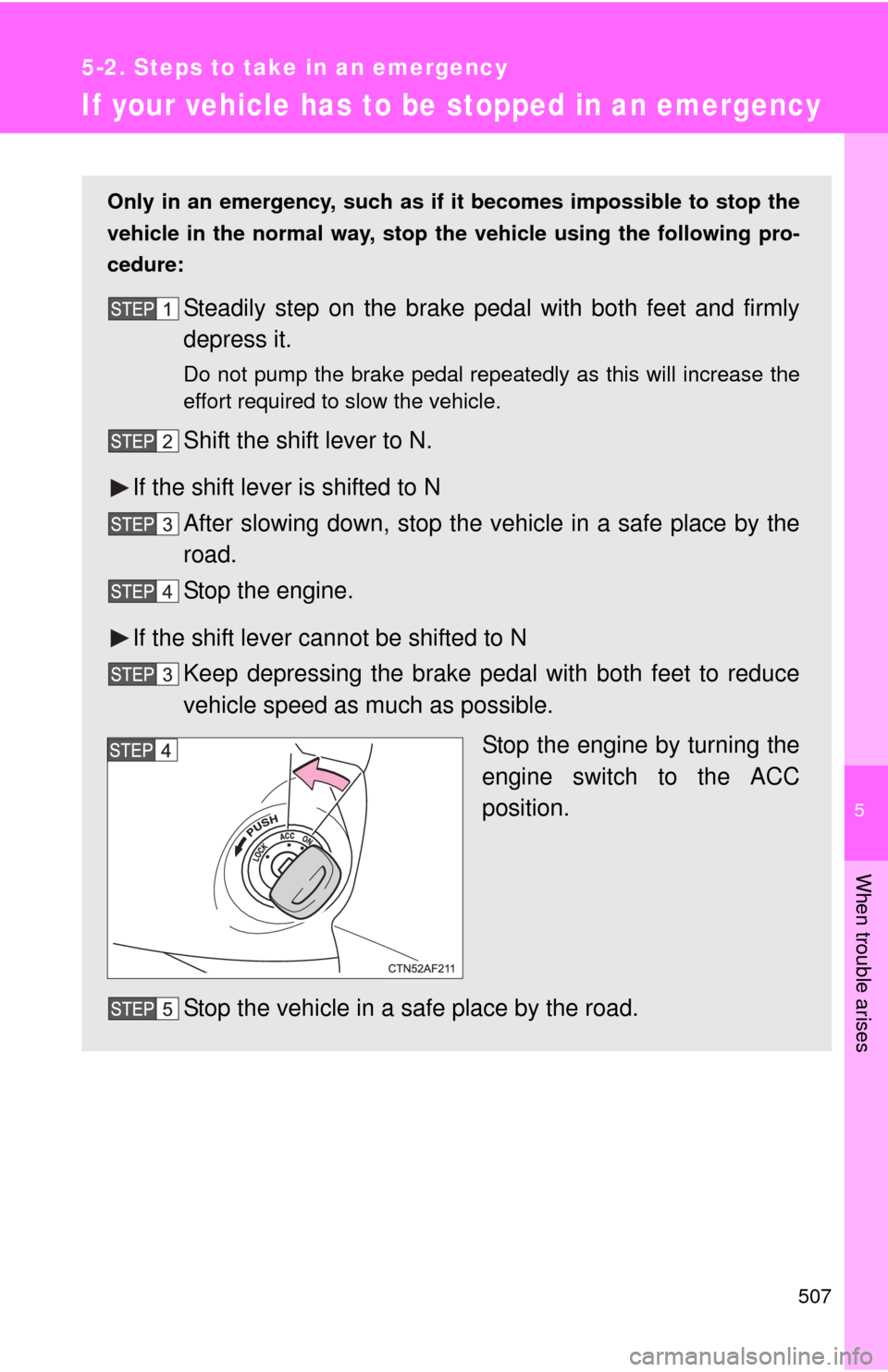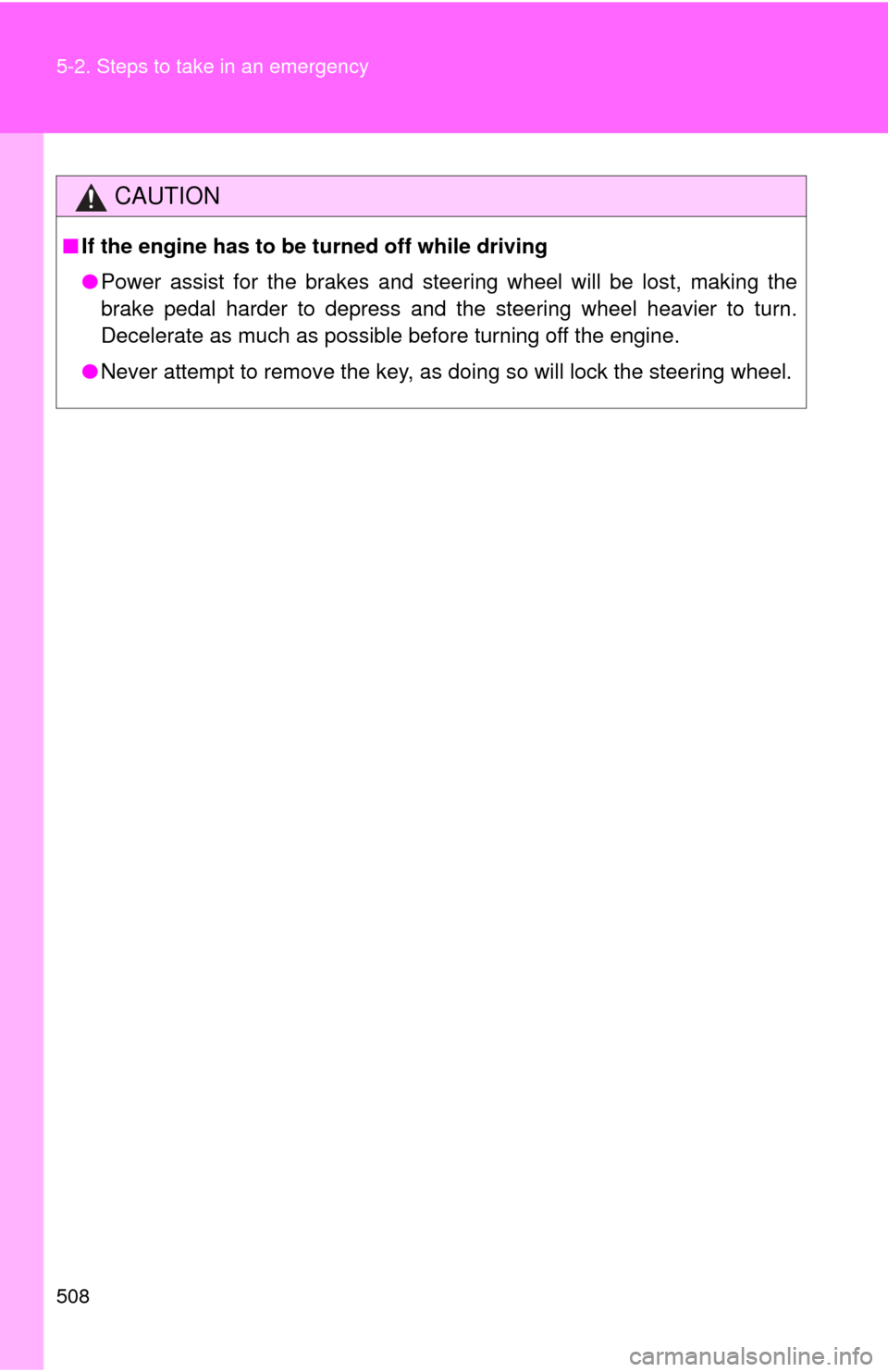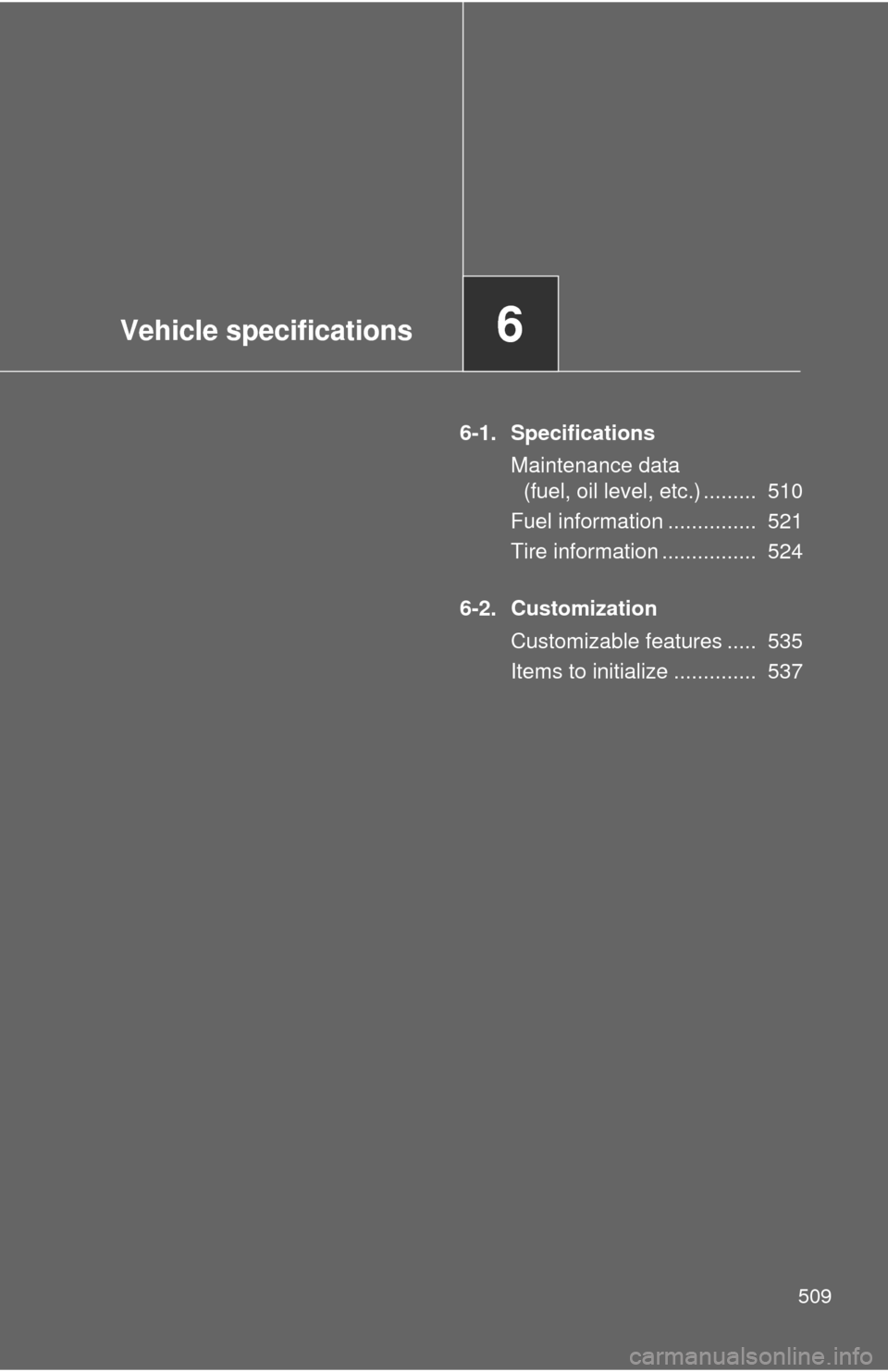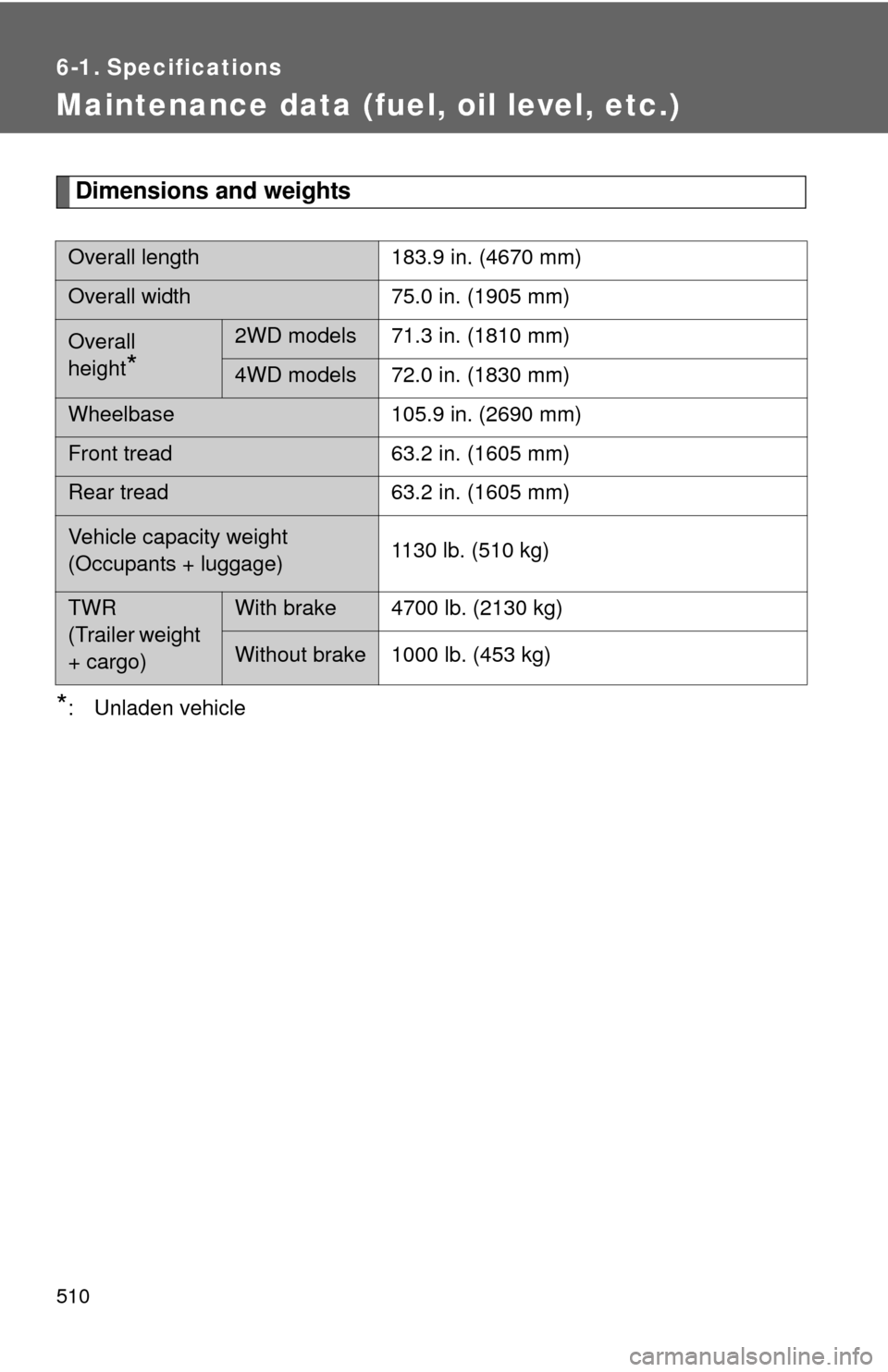TOYOTA FJ CRUISER 2013 1.G Owners Manual
FJ CRUISER 2013 1.G
TOYOTA
TOYOTA
https://www.carmanualsonline.info/img/14/6375/w960_6375-0.png
TOYOTA FJ CRUISER 2013 1.G Owners Manual
Trending: clock setting, adding oil, catalytic converter, brake fluid, flat tire, brake light, automatic transmission fluid
Page 501 of 568
5
When trouble arises
501
5-2. Steps to take in an emergency
NOTICE
■
To prevent damaging the vehicle (vehicles with a manual transmission)
Do not pull- or push-start the vehicle, because the three-way catalytic con-
verter may overheat and become a fire hazard.
■ When handling jumper cables
Be careful that the jumper cables do not become tangled in the cooling fan
or any of the belts when connecting or disconnecting them.
Page 502 of 568
502
5-2. Steps to take in an emergency
If your vehicle overheats
In the following cases, the vehicle may be overheating.
●Engine coolant temperature gauge needle ( P. 140) reaches
the upper end, and engine output falls (There is no speed).
● Steam is coming out from the engine compartment.
Perform the following steps.
Stop the vehicle in a safe place, turn off the air conditioning
system, and stop the engine.
If steam is coming out:
When no more steam is coming out has been confirmed,
carefully open the hood.
If there is no steam coming out:
Carefully open the hood. After the engine has cooled
down sufficiently, inspect the
radiator core (radiator), hoses,
etc. for any leaks.
If there is a large quantity of
engine coolant leaking, imme-
diately contact your Toyota
dealer.
Inspect the amount of engine
coolant by checking if the res-
ervoir level is between the F
(Full) and L (Low) lines.
Engine coolant reservoir
F (Full)
L (Low)
Page 503 of 568
5
When trouble arises
503
5-2. Steps to take in an emergency
■
Overheating
If you observe the following, your vehicle may be overheating.
●The engine coolant temperature gauge enters the red zone or a loss of
power is experienced.
● Steam is coming from under the hood.
Add engine coolant if neces-
sary.
Water can be used in an emer-
gency if engine coolant is
unavailable. ( P. 514)
Start the engine, check that the cooling fan is operating, as
well as double check that there are no leaks at the radiator
core and hoses.
If the fan does not operate:
Stop the engine immediately and contact your Toyota
dealer.
If the fan operates:
Have the vehicle inspected at the nearest Toyota dealer.
Page 504 of 568
504 5-2. Steps to take in an emergency
CAUTION
■To prevent an accident or injury when inspecting under the hood of
your vehicle
● If steam is seen coming from under the hood, do not open the hood until
the steam has subsided. The engine compartment may be very hot, caus-
ing serious injury such as burns.
● Keep hands and clothing away from the fan and other belts while the
engine is running.
● Do not loosen the radiator cap while the engine and radiator are hot.
Serious injury, such as burns, may result from hot coolant and steam
released under pressure.
NOTICE
■When adding engine coolant
Wait until the engine has cooled down before adding engine coolant.
When adding coolant, do so slowly. Adding cool coolant to a hot engine too
quickly can cause damage to the engine.
Page 505 of 568
5
When trouble arises
505
5-2. Steps to take in an emergency
If the vehicle becomes stuck
■Emergency hook
Carry out the following procedures if the tires spin or the vehicle
becomes stuck in mud, dirt, or snow.
Stop the engine. Set the parking brake and put the shift
lever in P (automatic transmission) or N (manual transmis-
sion).
Remove the mud, snow, or sand from around the stuck tire.
Place wood, stones or some other material to help provide
traction under the tires.
Restart the engine.
Turn off the VSC. ( P. 197, 198)
Carefully apply the accelerator to free the vehicle.
When your vehicle becomes stuck and
cannot move, the emergency hook is
used for another vehicle to pull your vehi-
cle out in an emergency.
Your vehicle is not designed to tow
another vehicle.
Do not use the rear hook. It is not
designed for towing.
Page 506 of 568
506 5-2. Steps to take in an emergency
CAUTION
■When attempting to free a stuck vehicle
If you choose to rock the vehicle back and forth to free it, make sure the sur-
rounding area is clear, to avoid striki ng other vehicles, objects or persons.
The vehicle may also lunge forward or lunge back suddenly as it becomes
free. Use extreme caution.
■ When shifting the shift lever
Vehicles with automatic transmission: Be careful not to shift the shift lever
with the accelerator pedal depressed.
This may lead to unexpected rapid acceleration of the vehicle that may
cause an accident and result in death or serious injury.
NOTICE
■To avoid damaging the transmission and other components
●Avoid spinning the wheels and do not rev the engine.
● If the vehicle remains stuck after trying these procedures, the vehicle may
require towing to be freed.
Page 507 of 568
5
When trouble arises
507
5-2. Steps to take in an emergency
If your vehicle has to be stopped in an emergency
Only in an emergency, such as if it becomes impossible to stop the
vehicle in the normal way, stop the vehicle using the following pro-
cedure:
Steadily step on the brake pedal with both feet and firmly
depress it.
Do not pump the brake pedal repeatedly as this will increase the
effort required to slow the vehicle.
Shift the shift lever to N.
If the shift lever is shifted to N After slowing down, stop the vehi cle in a safe place by the
road.
Stop the engine.
If the shift lever cannot be shifted to N Keep depressing the brake pedal with both feet to reduce
vehicle speed as much as possible.
Stop the engine by turning the
engine switch to the ACC
position.
Stop the vehicle in a safe place by the road.
Page 508 of 568
508 5-2. Steps to take in an emergency
CAUTION
■If the engine has to be turned off while driving
●Power assist for the brakes and steering wheel will be lost, making the
brake pedal harder to depress and the steering wheel heavier to turn.
Decelerate as much as possible before turning off the engine.
● Never attempt to remove the key, as doing so will lock the steering wheel.
Page 509 of 568
Vehicle specifications6
509
6-1. SpecificationsMaintenance data (fuel, oil level, etc.) ......... 510
Fuel information ............... 521
Tire information ................ 524
6-2. Customization Customizable features ..... 535
Items to initialize .............. 537
Page 510 of 568
510
6-1. Specifications
Maintenance data (fuel, oil level, etc.)
Dimensions and weights
*: Unladen vehicle
Overall length183.9 in. (4670 mm)
Overall width75.0 in. (1905 mm)
Overall
height
*
2WD models 71.3 in. (1810 mm)
4WD models 72.0 in. (1830 mm)
Wheelbase105.9 in. (2690 mm)
Front tread 63.2 in. (1605 mm)
Rear tread 63.2 in. (1605 mm)
Vehicle capacity weight
(Occupants + luggage)1130 lb. (510 kg)
TWR
(Trailer weight
+ cargo)With brake 4700 lb. (2130 kg)
Without brake 1000 lb. (453 kg)
Trending: lock, wipers, air filter, tires, mirror, door lock, ad blue

